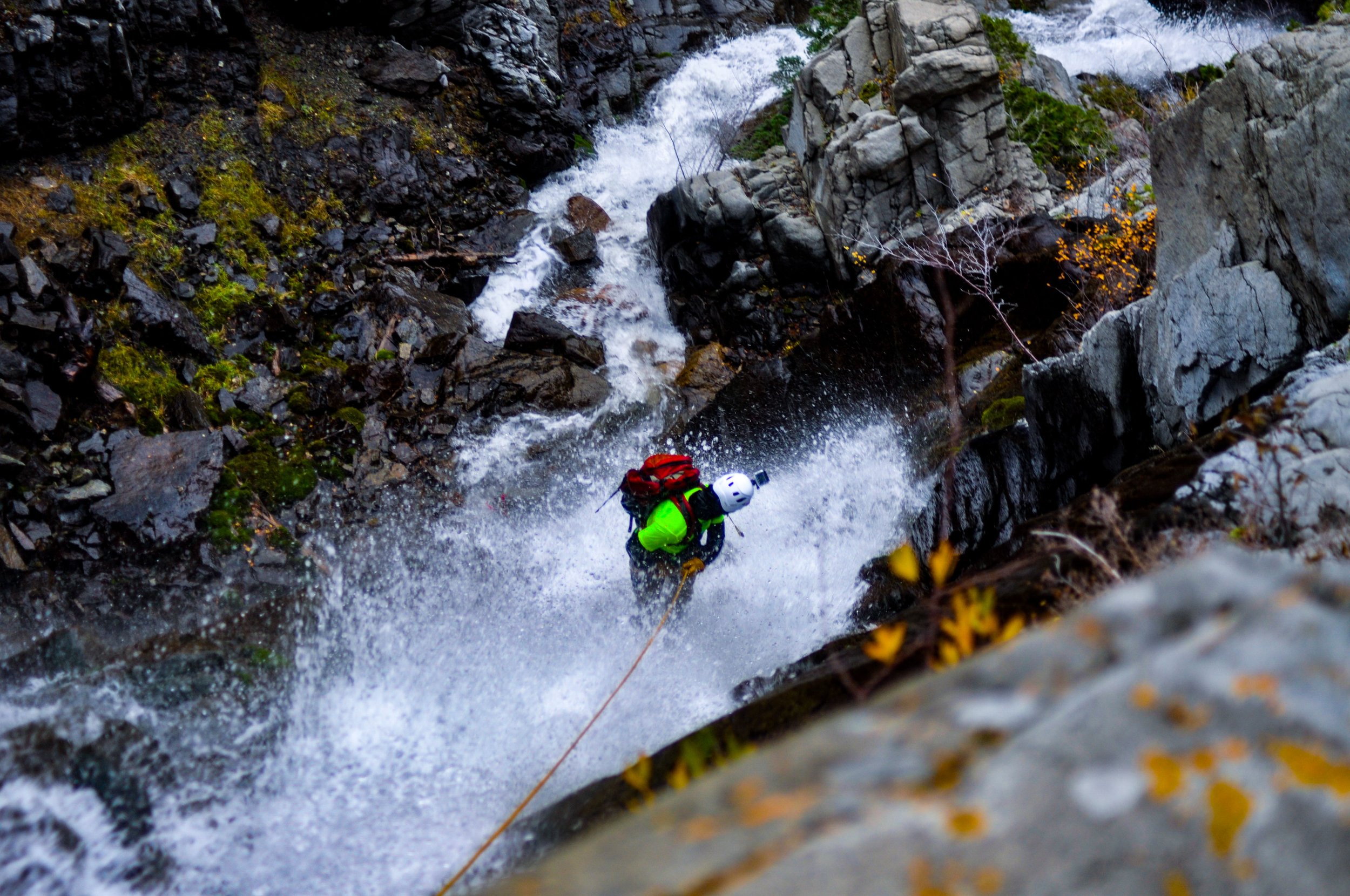
Montana canyoning orientation
The sport of canyoning definition:
“Canyoning (canyoneering in the United States, kloofing in South Africa) is a sport that combines several outdoor sports like rock climbing, hiking, swimming, and rappelling. A canyoneer travels down canyons using a variety of techniques that may include other outdoor activities such as walking, scrambling, climbing, jumping, abseiling (rappelling), and swimming.” - Wikipedia
Refining the definition:
Canyoning is the sport of descending technical (often aquatic) canyons. Participation of this sport involves competency in technical rope work, rappelling, hydraulic navigation, cold water exposure, advanced anchor building, terrain navigation and hiking.
Note: Failure of any of these competencies may result in injury, death or just an unpleasant outdoor experience (No one wants that).
So how should you navigate this site?
Well first, make sure you have the adequate training to descend aquatic canyons. As mentioned above, there is a lot to this sport. Please be sure to have competency in all areas before attempting any technical descent regardless of location. This will ensure that your time exploring the vast wilderness of Montana (or any other place) is spent having fun and not dying.
Additionally, please consider your skill set, time and desires before jumping into one of the forementioned canyons. If you are looking for a place to cool off on a hot summer day, you’ll find that here! If you are looking for a fast-moving, action-packed day with lots of challenges, you’ll also find that here. The important difference is knowing what YOU are looking for and NOT choosing the experience that may put yourself or others’ lives at risk.
Alrighty, enough parental talk, you are all adults (hopefully).
Let’s talk…. site navigation!
This website has been broken up by region for your convenience. There are 4 Montana regions ( one Idaho and one Washington region). Each region is then broken up by mountain range, which is then further broken down by canyon difficulty. This ensures that you will be able to locate the best adventure for your visiting region.
So written out it breaks down to:
State:Montana, Idaho or Washington
Region: Northern Idaho, Washington State, Southwest Montana, Central Montana, Northwest Montana and Glacier National Park.
Mountain range Ex: Beartooth/Absorka Range
Difficulty: Beginner, Intermediate, Advanced and Expert.
Canyon difficulty ratings
Okay, this next section is regarding how to choose what canyon is best fit for you. BUT before we jump into that, lets outline some of the circumstances that makes Montana’s canyons DIFFERENT from everywhere else.
These canyons are very remote, all parties must be prepared for self-rescue. There are NO technical teams in Montana that are prepared for canyon specific swift water rescue.
All technical canyons listed on this site do NOT have anchors. Parties MUST be proficient in both anchor building and advanced ghosting methods.
These canyons are NOT like your PNW canyons or frankly anywhere else. I would argue that many of these canyons are like mini golf, and by mini golf I mean most of these canyons have short technical sections (There are some significant expectations). DO NOT ASSUME THAT THESE CANYONS ARE EASY.
Most if not all of the canyons stated on this website are swift water and carry significant water flow. They are small, but FEISTY.
Many of these canyons do NOT slot up like you would traditionally see in the southwest or PNW (once again there are exceptions).
Please also note that many of these canyons contain very cold water. It is recommended that parties wear a wetsuit that is at least 4mm/3mm thick.
Universally accepted ratings for canyon characteristics
HA! There aren’t any. Well, I shouldn’t say that. There are two respected canyon rating systems:
The American Canyoneering Association (Produced in the 2000s)
Fédération Française de la Montagne et de l’Escalade and Fédération Française de Spéléologie, AKA FFME. (Also produced in the 2000s, but has had significant more acceptance and integration around the world compared to the ACA_)
I bet you can take a guess on what rating system we use…
BOTH! (Though for most purposes please use the FFME rating)
Also, I am not going to spoon feed you rating systems. I have included other website links that explain the rating systems in a much better capacity than I ever could.
You may find the ACA rating system here.
You may find the FFME rating system here.
Gnarly, now that you know what you are getting into, let’s talk about what this website will help you with!
… and also how to use it most effectively since my beta is like drinking from a fire hose.
Beta (Logistical information) for each canyon is organized by a small write up that will help you understand the canyon’s experience. It is then followed by information on its rating, longest rappel, special considerations and hydraulic information. I will also give you the entrance, technical section and exit information.
Notably, at the end of each canyon write up you will find GPS tracks, canyon sheets and maps!
We RECOMMEND reading the long beta once, and then print out either the basic or advanced canyon sheet.
Advanced canyoneers may just print or load the canyon sheets, that’s okay with us. Just be careful.
… and that’s about it for orientation. Go out there and explore! It is a big world out there.
